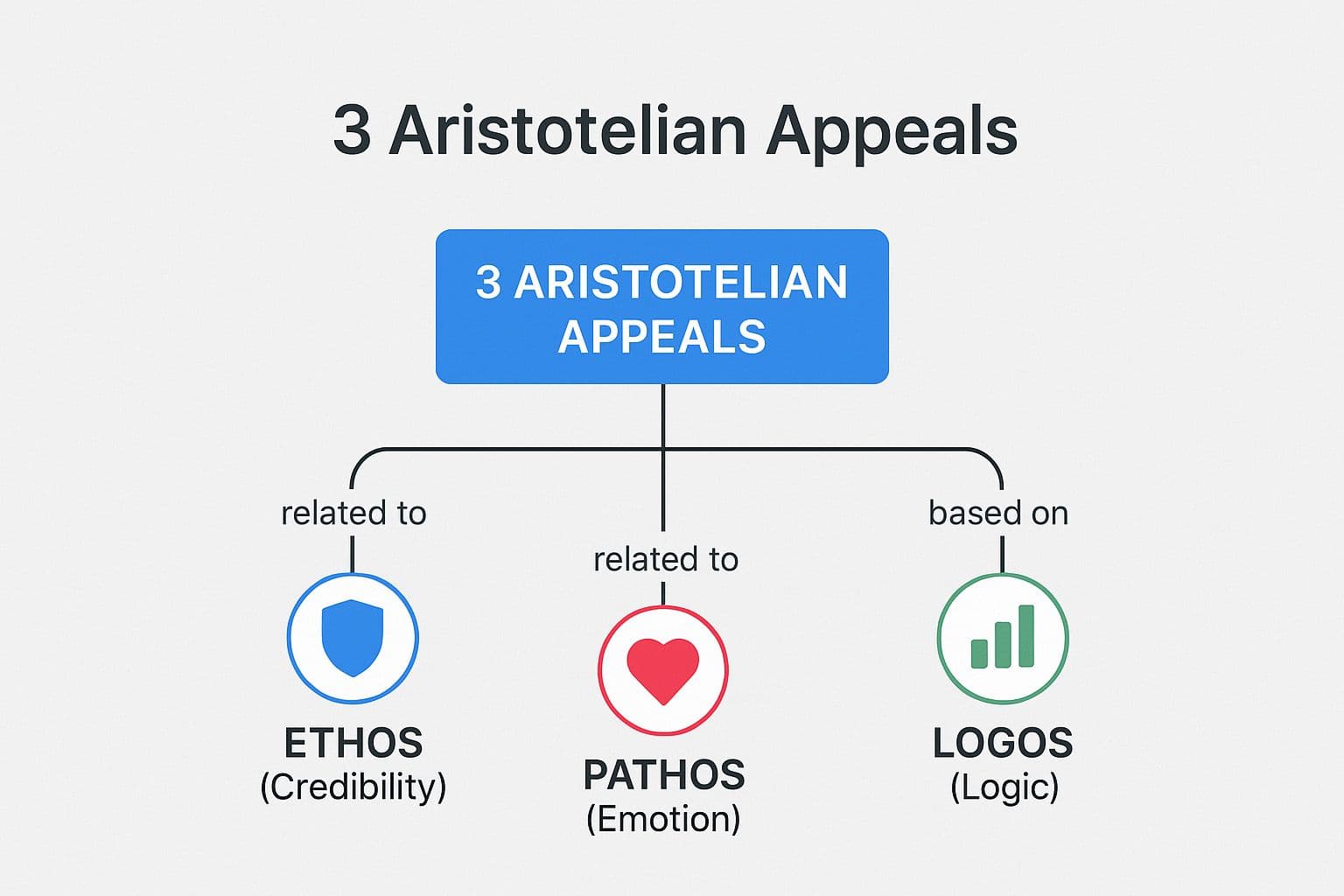7 AI Writing Techniques for Better, Faster, More Persuasive Text
Discover the top 7 techniques for persuasive writing strategies and tips. Complete guide with actionable insights.

Ever feel like you spend too much time staring at a blank page? You need to write an email, a social media post, or a project update, but getting the words right takes forever. For many of us, writing isn't just about creativity; it's a daily task that can feel like a major productivity bottleneck. This is where mastering a few core techniques for persuasive writing with the help of AI can completely change your daily workflow. Strong, efficient writing skills are essential, whether you're trying to win over a new client, communicate a complex idea, or simply get your team on board with a new plan.
This isn't just about sounding more professional; it's about making your daily communication more impactful and reclaiming your time. For solopreneurs, creators, and professionals, effective writing directly translates to growth and efficiency. The good news is that you don't need to be a natural-born writer to get better. With modern text-based AI tools, you can apply powerful principles to be more productive, gain meaningful benefits, and turn writing from a chore into a strength.
In this guide, we'll break down seven practical, AI-powered techniques you can start using today. We'll move beyond generic advice and give you actionable prompts and frameworks for each. You’ll learn how to structure your arguments, connect with your audience, and build credibility, all while using AI to streamline your daily tasks and stay in your creative flow. Let’s get started.
1. Ethos, Pathos, and Logos (The Persuasion Check)
Let's start with a foundational technique for making your writing more effective: the three Aristotelian appeals. This timeless trio of ethos, pathos, and logos is perfect for AI-powered text analysis because it targets the core ways humans are convinced. Think of them as a simple checklist for your AI assistant to run on any important text to ensure your message is balanced and impactful.
How It Works
These three appeals work together to build a comprehensive and convincing case. In your daily life, this means ensuring your emails, reports, or messages cover all the bases.
- Ethos (Credibility): This is the "why you should listen to me" appeal. Are you showing you're trustworthy? This can be as simple as a confident tone or citing a reliable source.
- Pathos (Emotion): This is your connection to the reader. Are you making them feel something? A short, relatable anecdote or a powerful word choice can make all the difference.
- Logos (Logic): This is the appeal to reason. Does your argument make sense? It involves using clear reasoning, data, or facts to back up your claims.
The following concept map visualizes how these three distinct appeals connect to form a powerful, unified persuasive strategy.

As the infographic shows, the most effective arguments blend credibility (ethos), emotion (pathos), and logic (logos) to create a well-rounded and compelling case.
AI-Powered Implementation Tips
To apply this, start by asking your AI assistant to analyze your draft for its balance of ethos, pathos, and logos. Productivity Prompt: "Analyze this draft email and tell me how I can strengthen my use of ethos, pathos, and logos to be more persuasive." The AI can instantly pinpoint where you've over-relied on data without an emotional hook or where you've made claims without establishing your credibility. This turns a complex theory into a quick, actionable check for your daily writing. For a deeper dive, explore more persuasive techniques to complement this foundational approach.
2. Storytelling (The Narrative Generator)
While logic is important, humans are wired for stories. A quick story can make a dry report or a boring email suddenly engaging. This is one of the most powerful techniques for persuasive writing because it makes abstract concepts feel tangible and relatable. The meaningful benefit is that a good story makes your message memorable and much more likely to be acted upon.

This technique works by creating an emotional connection that hard data alone cannot achieve. It’s why a single personal anecdote in a presentation is often more memorable than a slide full of statistics.
How It Works
Storytelling persuades by wrapping your core message in a simple narrative structure. For daily productivity, this doesn't have to be an epic tale. It just needs a relatable character, a challenge, and a resolution that reinforces your point.
- Emotional Engagement: Stories create empathy. A quick story about a customer's success makes a business update more impactful.
- Concreteness: Abstract ideas like "efficiency" are hard to grasp. A story makes them concrete. Instead of saying your new process saves time, tell a one-sentence story about how it helped a team member leave an hour early.
- Memorability: Our brains remember narratives far better than lists of facts. A good story sticks with your audience long after they’ve finished reading.
By embedding your goal within a brief narrative, you guide the reader to their own conclusion, which is always more powerful than simply being told what to think.
AI-Powered Implementation Tips
You can leverage AI to become a faster, more effective storyteller in your daily work. Use your AI assistant to instantly generate story ideas or flesh out rough ones. Productivity Prompt: "I need to explain the benefit of our new software feature. Give me a short, one-paragraph story about a user who was struggling with [problem] and used the feature to achieve [positive outcome]." The AI can outline a compelling micro-narrative, suggest sensory details, and help you draft different versions, transforming a blank page into a finished story in seconds.
3. Social Proof and Authority (The Credibility Booster)
This powerful duo plays on a fundamental human instinct: when we are uncertain, we look to others for guidance. Social proof shows that others agree with you, while authority leverages the credibility of experts. This is one of the most effective techniques for persuasive writing because it outsources the hard work of building trust. For daily productivity, it means you can make your text more convincing without writing more.

How It Works
These two concepts work in tandem to reduce your reader's hesitation and make your claims feel safer and more reliable.
- Social Proof (The Bandwagon Effect): This technique demonstrates that others have already adopted a belief or taken an action. In daily work, this could be mentioning, "The marketing team has already seen great results with this."
- Authority (The Expert Endorsement): This establishes credibility by associating your message with a respected source. This could be citing an industry report or quoting a recognized expert.
By combining the two, you create a compelling argument that appeals to both our need for social belonging and our respect for expertise. To further understand how social proof works in practice, you might explore various resources providing examples of social proof.
AI-Powered Implementation Tips
You can use AI to quickly find and integrate these elements into your writing. Use it as a super-fast research assistant. Productivity Prompt: "Find a recent statistic or an expert quote from a reputable source about the benefits of [your topic] that I can add to my report." The AI can scan the web for data points and endorsements you can weave into your content. You can also prompt it with, "Rewrite this paragraph to include this customer testimonial," helping you seamlessly integrate proof without disrupting your flow.
4. Scarcity and Urgency (The Action Trigger)
Ever felt that rush to act on a "limited-time offer"? That powerful pull is the result of scarcity and urgency, two of the most effective techniques for persuasive writing. This method is rooted in the psychological principle that we desire things more when they are limited. It triggers our fear of missing out (FOMO) and compels us to act now rather than later. In daily life, it helps you get responses and decisions faster.
How It Works
This technique creates persuasive pressure by highlighting limitations, which in turn makes the opportunity feel more valuable.
- Scarcity (Limited Supply): This principle suggests that opportunities seem more valuable when availability is limited. For example, "I only have two slots open for a meeting this week."
- Urgency (Limited Time): This creates a deadline for action, preventing procrastination. "Please provide feedback by EOD so we can hit our deadline."
These two forces work together to cut through indecision. Scarcity makes the opportunity desirable, while urgency provides the catalyst for immediate action.
Before: Vague Request Our new team workshop is available for sign-ups. Let me know if you want to join.
After: Using Scarcity and Urgency There are only 5 spots left for our team workshop, and sign-ups close Friday at noon. Claim your spot now to make sure you don't miss out!
The "After" example is far more compelling because it introduces clear limitations on both availability (5 spots) and time (Friday at noon), making the decision feel both important and immediate.
AI-Powered Implementation Tips
You can use AI to skillfully weave scarcity and urgency into your daily communications without sounding pushy. Ask your AI assistant to generate variations of your call to action. Productivity Prompt: "Rewrite this meeting request to create a polite sense of urgency. Give me two options." This lets you test different phrasings quickly while ensuring the claims remain authentic and professional. For more ideas on ethically applying these tactics, this CXL article on Cialdini's principles offers a great deep dive.
5. Reciprocity (The Value-First Approach)
Ever received an unexpected free template and felt more inclined to work with the person who sent it? That is the principle of reciprocity in action. This is one of the most powerful and ethical techniques for persuasive writing because it flips the traditional script. Instead of asking for something, you start by giving something of value first, tapping into the human instinct to return a favor.
How It Works
The reciprocity principle states that people feel a social obligation to give back after they've received something. By providing genuine, upfront value, you build goodwill and trust, making your audience more receptive when you eventually make a request. The meaningful benefit is stronger relationships and more positive responses.
- Lead with Generosity: Offer a helpful link, a useful summary of a meeting, or a template that can solve a problem for your colleague or client.
- Establish Trust: When you help someone without asking for anything in return, you demonstrate that you care about their success. This builds a foundation of trust that makes future collaboration much smoother.
- Create a Positive Association: Your colleagues and clients begin to associate you with helpfulness and expertise.
By leading with a value-first approach, you transform your daily interactions from simple transactions into mutually beneficial relationships.
AI-Powered Implementation Tips
Use your AI assistant to brainstorm and create high-value "freebies" at scale to use in your daily work. Productivity Prompt: "I'm emailing a potential client who is a freelance web designer. Generate an idea for a helpful checklist I can include in my email to provide value upfront. Outline the main points." The AI can help you create useful resources in seconds, allowing you to consistently apply this powerful relationship-building technique without adding hours to your day.
6. Emotional Framing (The Tone Shifter)
While we've touched on pathos, this technique dives deeper into how the specific emotional frame you use can change how your message is received. It involves strategically using psychological frames like gain vs. loss, or problem vs. opportunity to create a specific response. This is one of the most effective techniques for persuasive writing because it acknowledges that how you say something is often as important as what you say.
How It Works
This method focuses on creating a specific emotional state in your reader that makes them receptive to your message. It's about consciously choosing the lens through which your audience views your information.
- Loss Aversion: Highlighting what could be lost is often more powerful than highlighting what could be gained. "If we don't act now, we risk losing the client."
- Hope/Aspiration: Focusing on a desirable future can inspire action and excitement. "This new strategy will position us as leaders in the industry."
- Problem/Opportunity: Framing a challenge as an "opportunity for growth" instead of a "critical problem" can shift the entire tone from negative to positive.
By choosing the right emotional frame, you can guide the conversation and motivate action more effectively.
AI-Powered Implementation Tips
You can use AI to instantly reframe your text to achieve a specific tone. This is a massive productivity win, saving you from rewriting sentences over and over. Productivity Prompt: "Rewrite this status update. Right now it focuses on the problems we're facing. Reframe it to focus on the opportunities for improvement and our plan to achieve them." The AI can help you select more positive, motivating language, ensuring your communications build morale and drive progress. For a more comprehensive look at maintaining consistency, explore how to build a strong brand voice.
7. Problem-Solution Framework (The Clarity Builder)
Few techniques for persuasive writing are as direct and effective for daily productivity as the Problem-Solution framework. This approach gets straight to the point. By first identifying a specific problem, you create a clear context and a need for a fix. Then, you present your idea or request as the logical, satisfying answer.
How It Works
This framework creates a clear, logical flow that guides your reader from a state of confusion or frustration to one of clarity and action.
- Problem (The "Why"): You begin by clearly articulating a problem. This isn't just a generic issue; it's a specific, relatable pain point. The goal is to make your reader nod along and think, "Yes, that's exactly the issue."
- Solution (The "How"): Once the problem is established, you introduce your solution. This is where you connect the dots, showing precisely how your proposed action solves the problem. The solution should feel like the perfect key for the lock you just presented.
This one-two punch is highly effective for daily communications like emails and meeting agendas because it respects the reader's time and focuses on action. A key application of this framework is in creating winning business proposals.
AI-Powered Implementation Tips
To effectively use this technique, leverage AI to structure your thoughts quickly and clearly. Productivity Prompt: "I need to write an email to my team about improving our weekly meetings. Use the Problem-Solution framework. The problem is that meetings are too long and unfocused. The solution is a new timed agenda. Draft the email for me." This prompt helps you turn a jumble of ideas into a perfectly structured, persuasive message in seconds. To master this for client work, you can learn how to apply this framework to proposals.
Techniques for Persuasive Writing: 7-Item Comparison
| Technique | Implementation Complexity 🔄 | Resource Requirements ⚡ | Expected Outcomes 📊 | Ideal Use Cases 💡 | Key Advantages ⭐ |
|---|---|---|---|---|---|
| Ethos, Pathos, and Logos | Low - with AI prompts | Low - an AI assistant and a draft | Well-rounded, balanced, and more convincing text | Important emails, reports, presentations, client communication | Quick to check, improves overall message effectiveness |
| Storytelling and Narrative Persuasion | Moderate - requires a clear goal | Low - an AI assistant | High emotional impact, memorable, engaging communication | Team updates, marketing messages, explaining complex ideas | Makes abstract ideas concrete, highly memorable |
| Social Proof and Authority | Low - with AI research prompts | Low - an AI assistant | Immediate credibility and influence, builds quick trust | Sales emails, proposals, internal recommendations | Boosts believability with minimal effort |
| Scarcity and Urgency | Low - with AI rewriting prompts | Low - an AI assistant | Increased urgency, faster responses, drives action | Scheduling, event invites, calls to action | Cuts through procrastination, motivates decisions |
| Reciprocity and Value-First Approach | Moderate - requires thinking of a "gift" | Low to Moderate - AI for brainstorming/creating | Builds goodwill, strengthens relationships, positive replies | Networking, client outreach, team collaboration | Fosters trust, highly ethical, creates positive association |
| Emotional Framing and Tone Shifter | Low - with AI reframing prompts | Low - an AI assistant | Better tone, increased motivation, positive perception | Status updates, feedback delivery, change management | Instantly shifts perspective, improves morale |
| Problem-Solution Framework | Low - with AI structuring prompts | Low - an AI assistant | Clear, logical, and actionable communication | Project proposals, update emails, meeting agendas | Highly efficient, respects reader's time, drives action |
Final Thoughts
You’ve just explored a powerful AI-powered toolkit of techniques for persuasive writing, designed to make your daily communication faster, easier, and more effective. We've seen how simple AI prompts can help you check for Ethos, Pathos, and Logos, generate quick stories, and frame your messages for maximum impact.
But here’s the secret: these techniques aren't just isolated tricks. They are productivity principles for modern work. The most efficient communicators layer them. A clear Problem-Solution email (Clarity) can be amplified with a quick, relatable story (Pathos) and backed by a single, powerful data point (Logos). A value-first message (Reciprocity) feels even more compelling when it includes a clear call to action with a deadline (Urgency).
Putting Persuasion into Practice with AI
As a busy professional, your time is your most valuable asset. Mastering these techniques doesn't mean spending hours agonizing over every word. This is where leveraging AI as your co-pilot becomes a game-changer. Think of your AI assistant not as a replacement for your ideas, but as an accelerator for your daily tasks.
You can use AI to:
- Structure Your Thoughts: Give it a messy brain dump and ask it to structure it using the Problem-Solution framework.
- Refine Your Tone: Paste a draft and ask it to "make this sound more confident and authoritative" or "rephrase this to be more collaborative."
- Overcome Writer's Block: Stuck on an opening line? Prompt your AI to generate five different ways to start your email.
This AI-assisted workflow helps you move from idea to execution in seconds, allowing you to reclaim your time and gain meaningful benefits from more effective communication. The goal is to integrate these techniques for persuasive writing so deeply into your daily process that they become second nature.
Your Next Steps to Becoming a More Productive Writer
True mastery comes from consistent application. Don't try to do everything at once. Instead, pick one or two AI prompts from this article and focus on using them for the next week. Maybe you decide to use the Problem-Solution prompt for all your update emails or use the Ethos/Pathos/Logos check on any important message before you hit send.
Track the results. Did you get faster replies? Were your meetings more focused? This feedback loop is crucial for seeing the real-world benefits. To truly maximize the impact of your persuasive writing, consider additional strategies for achieving strong audience engagement, such as these 10 Proven Ways to Boost Social Media Engagement. By pairing persuasive copy with smart engagement tactics, you create an unstoppable force for connection and conversion.
Ultimately, using AI to write more persuasively is an act of empathy and efficiency. It’s about understanding your audience’s needs so you can communicate clearly and respectfully, all while saving yourself valuable time. Keep practicing, keep prompting, and keep focusing on clear, valuable communication. The results will speak for themselves.
Ready to apply these techniques faster and more effectively across all your apps? TypeBoost is an AI-powered writing assistant that integrates seamlessly into your existing workflow, helping you refine tone, generate ideas, and write persuasive content without ever leaving your text editor. Supercharge your writing and start persuading with confidence by trying TypeBoost today.